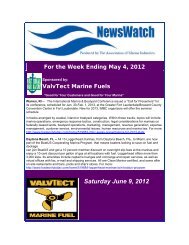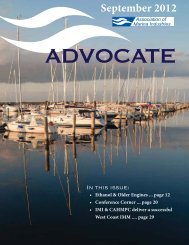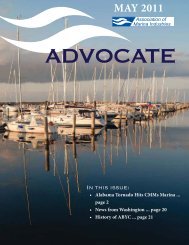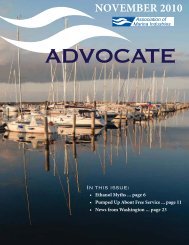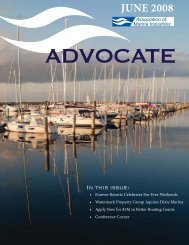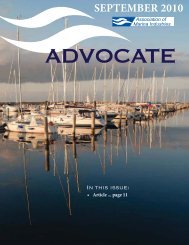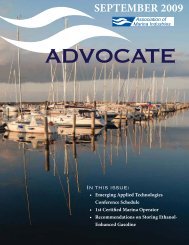Download a copy of AMI's Clean Marina best management practices ...
Download a copy of AMI's Clean Marina best management practices ...
Download a copy of AMI's Clean Marina best management practices ...
You also want an ePaper? Increase the reach of your titles
YUMPU automatically turns print PDFs into web optimized ePapers that Google loves.
Siting Considerations and <strong>Marina</strong> Design<br />
Redevelop Existing Sites<br />
• Place new facilities in previously developed waterfront sites.<br />
• Expand marinas into previously developed sites.<br />
• Check with your local government for preferred redevelopment activities and locations.<br />
Avoid Rare and Endangered Species<br />
• Rare and endangered species may not be disturbed per the Federal & State Endangered Species<br />
Act/Legislation.<br />
• Get a preliminary screening through you state agency that handles endangered species.<br />
• If protected species are identified, you must implement an approved protection plan prior to project<br />
approval.<br />
Avoid Submerged Aquatic Vegetation<br />
• Avoid disturbing or shading SAV.<br />
• Avoid creating situations where secondary impacts on SAV by boat traffic (i.e. prop scarring or erosion<br />
from wakes) can occur.<br />
Minimize Disturbance to Wetlands<br />
• Avoid disturbance to wetlands and indigenous vegetation in riparian areas.<br />
• Build open piled docks at a height minimizing shading impacts to marshes (build docks at least 1 foot<br />
in height above substrate for every 1 foot <strong>of</strong> dock width).<br />
• Remove foreign materials (trash) from wetlands.<br />
Avoid Shellfish Waters<br />
• Avoid construction that results in the condemnation <strong>of</strong> shellfish waters. Many states have established<br />
policies that require creating buffer zones around boat mooring facilities within which shellfish cannot<br />
be harvested for direct marketing during certain months <strong>of</strong> the year.<br />
• Do not site a marina near active shellfish harvesting or culturing areas.<br />
Avoid Critical Migration, Nesting, and Spawning Areas for Location and Construction<br />
• Disturbance <strong>of</strong> waterfowl staging areas by marinas and increased boat traffic should be avoided.<br />
• Schedule construction to avoid critical migration, nesting, and spawning periods <strong>of</strong> important finfish,<br />
shellfish, and wildlife.<br />
Consider Bottom Configuration<br />
• Locate marinas on well-flushed, natural waterways; A continuous, gradual downward slope from the<br />
berthing area into deeper water is ideal.<br />
• Avoid locating in canals (especially dead-end canals), irregular pockets, and sumps that are deeper than<br />
adjacent channels.<br />
• Build docks in areas with water depths greater than 3 feet at mean low water.<br />
Minimize Impervious Areas to Reduce Run<strong>of</strong>f<br />
• Maintain areas with grass or gravel or other materials that let water percolate-- where water and the<br />
pollutants (fertilizer, etc.) it picks up is filtered naturally before reaching the waters <strong>of</strong> your marina.<br />
• Keep paved areas to an absolute minimum, i.e., just designate work areas and roadways for heavy<br />
equipment.<br />
1



